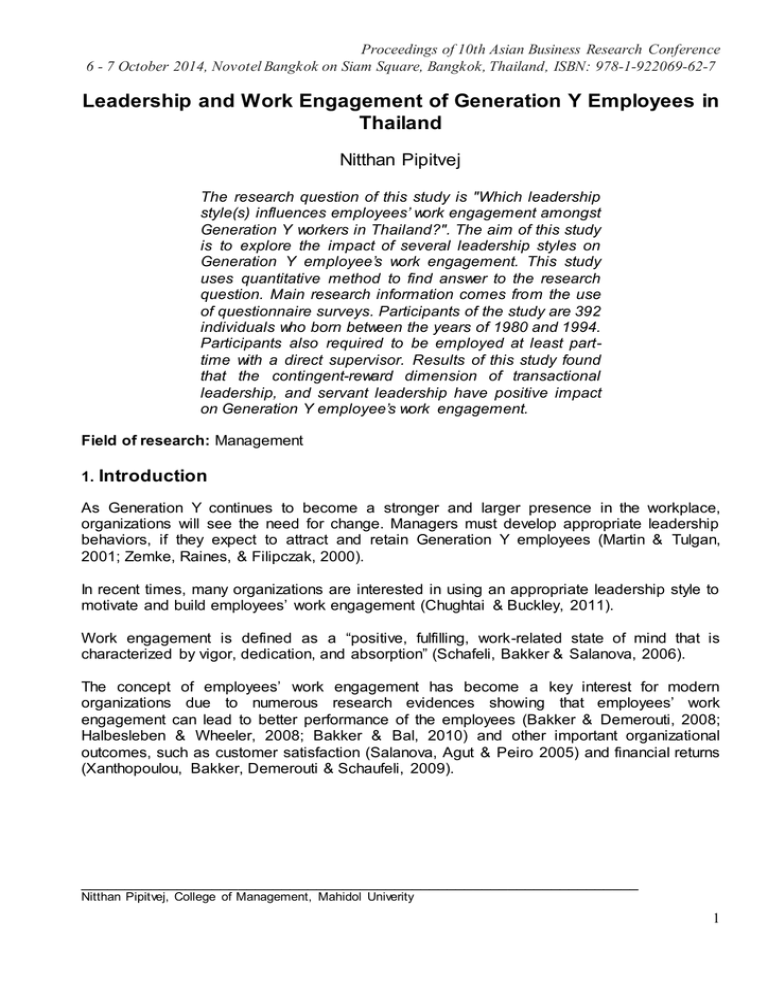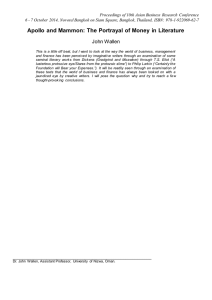
Proceedings of 10th Asian Business Research Conference
6 - 7 October 2014, Novotel Bangkok on Siam Square, Bangkok, Thailand, ISBN: 978-1-922069-62-7
Leadership and Work Engagement of Generation Y Employees in
Thailand
Nitthan Pipitvej
The research question of this study is "Which leadership
style(s) influences employees’ work engagement amongst
Generation Y workers in Thailand?". The aim of this study
is to explore the impact of several leadership styles on
Generation Y employee’s work engagement. This study
uses quantitative method to find answer to the research
question. Main research information comes from the use
of questionnaire surveys. Participants of the study are 392
individuals who born between the years of 1980 and 1994.
Participants also required to be employed at least parttime with a direct supervisor. Results of this study found
that the contingent-reward dimension of transactional
leadership, and servant leadership have positive impact
on Generation Y employee’s work engagement.
Field of research: Management
1. Introduction
As Generation Y continues to become a stronger and larger presence in the workplace,
organizations will see the need for change. Managers must develop appropriate leadership
behaviors, if they expect to attract and retain Generation Y employees (Martin & Tulgan,
2001; Zemke, Raines, & Filipczak, 2000).
In recent times, many organizations are interested in using an appropriate leadership style to
motivate and build employees’ work engagement (Chughtai & Buckley, 2011).
Work engagement is defined as a “positive, fulfilling, work-related state of mind that is
characterized by vigor, dedication, and absorption” (Schafeli, Bakker & Salanova, 2006).
The concept of employees’ work engagement has become a key interest for modern
organizations due to numerous research evidences showing that employees’ work
engagement can lead to better performance of the employees (Bakker & Demerouti, 2008;
Halbesleben & Wheeler, 2008; Bakker & Bal, 2010) and other important organizational
outcomes, such as customer satisfaction (Salanova, Agut & Peiro 2005) and financial returns
(Xanthopoulou, Bakker, Demerouti & Schaufeli, 2009).
________________________________________________________________
Nitthan Pipitvej, College of Management, Mahidol Univerity
1
Proceedings of 10th Asian Business Research Conference
6 - 7 October 2014, Novotel Bangkok on Siam Square, Bangkok, Thailand, ISBN: 978-1-922069-62-7
The majority of studies on the linkage between leadership styles and work engagement
(Dibley, 2009; Elzette, 2012; Ghadi, Fernando & Caputi, 2013; Kesteren, 2010; Koppula,
2008; Raja, 2012; Vincent-Höper, Muser & Janneck, 2012) focused heavily on
transformational leadership, a leadership style that is widely adopted by modern
organizations. However, little is known about other styles of leadership.
This study main purpose is to explore the impact of various leadership styles on Generation
Y’s work engagement in Thailand.
2. Literature review
2.1 Work engagement
Schaufeli, Salanova, Gonzalez-Roma & Bakker (2002) defined engagement as a positive,
fulfilling, work-related state of mind that is characterized by vigor, dedication, and absorption.
They further explained each of the three components of engagement as followed: vigor is
characterized by high levels of energy and mental resilience while working; dedication is
characterized by being strongly involved in one's work; and absorption by being fully
concentrated and happily engrossed in one’s work (Schaufeli & Bakker, 2010; Schaufeli et
al., 2002).
The study of Anitha (2012) showed that leadership is one of the antecedents that facilitate
work engagement which means that appropriate leadership style can create employee work
engagement.
2.2 Leadership theories
There are 4 approaches to the theory of leadership namely, trait theory, leadership behaviors
approach, situational and contingency leadership approach, and contemporary leadership
approach.
The trait theory is a concept which stated that effective leaders possess certain traits and
they are different from other people in certain key respects (Kirkpatrick & Locke, 1991). The
concept emphasizes that not every individual can be a great leader.
Leadership behaviors approach is an approach of study that emphasizes two behaviors of
leaders namely, task-oriented behaviors and people-oriented behaviors. The study of Lewin,
Lippitt and White (1939) found that leadership can be classified into three types according to
the behaviors of the leader. They are autocratic leadership style, democratic leadership style ,
and laissez-Faire leadership style. Autocratic leaders are task-oriented. Democratic leaders
are leaders who offer guidance to their subordinates and place concern on both production
and people. Laissez-Faire leaders are the ones who let their subordinates work freely on
their own by offer little or no guidance at all (Lewin et al., 1939).
Situational and contingency leadership approach emphasizes that leaders should be flexible
and they should change their leadership styles according to each situation they are facing.
The theory suggested that there is no ideal leadership style.
2
Proceedings of 10th Asian Business Research Conference
6 - 7 October 2014, Novotel Bangkok on Siam Square, Bangkok, Thailand, ISBN: 978-1-922069-62-7
Contemporary leadership models argue that effective leaders are ones who have the
capacity to recognize and react to complexity in their environments (Denison, Hooijberg &
Quinn, 1995).
Contemporary leadership styles that will be discussed in this study are transacti onal &
transformational leadership, servant leadership, and level 5 leadership.
Transactional & Transformational Leadership
Burns (1978) introduced two contrasting leadership concepts namely, transforming
leadership and transactional leadership. Transactional leadership involves exchange of
tangible rewards for the work and loyalty of followers and working within existing systems to
maintain the status quo (Burns, 1978).
In contrast, transforming leadership concept is about "leaders and followers raise one
another to higher levels of morality and motivation" (Burns, 1978 p. 20).
Podsakoff, MacKenzie, Moorman and Fetter (1990) expanded upon Burns (1978)’s ideas
and stated that transformational leaders make their subordinates do more than they are
expected to do. According to Podsakoff et al. (1990), there are six dimensions of
transformational leadership namely, fostering the acceptance of group goals, individualize
support, intellectual stimulation, providing an appropriate role model, creating high
performance expectation, and articulating a vision.
Servant leadership
Greenleaf (1970) proposed the concept of servant leadership. The concept involved
advocating leaders’ primary objective and role as service to others. Traditionally, leadership
involves the exercising of leaders’ power to direct subordinates to get the job done. However,
servant leadership concept proposed that a leader should put the needs of others first and
helps subordinates develop and perform as highly as possible.
Level 5 leadership
The concept of level 5 leadership was introduced by Collins (2001).Collins argued that
humility and professional will are two important constructs of Level 5 leadership (Collins,
2001). In term of Humility, Collins (2001) concluded that truly great leaders act with modesty
and give credits to those around them. In term of professional will, Collins (2001) concluded
that great leaders have a workmanlike diligence.
2.3Generational theory
A generation is defined as an identifiable group that shares birth years and significant life
events at critical developmental stages (Kupperschmidt, 2000). A generational cohort
includes those who share historical life events or experiences that have a stable effect over
their lives.
Members of the Generation Y are the people who were born between 1980 and 1999
(Brosdahl & Carpenter’s, 2011). Members of the Generation Y embrace technologies
because they were brought up around them (Spiro, 2006). Spiro (2006) found that members
3
Proceedings of 10th Asian Business Research Conference
6 - 7 October 2014, Novotel Bangkok on Siam Square, Bangkok, Thailand, ISBN: 978-1-922069-62-7
of the Generation Y put value on balance and flexibility, especially with respect to a work-life
balance.
Hypotheses Development
The overall behaviors and attitudes of Generation Y were explored to see that which type of
leadership styles should match with their characteristics and preferences.
Previous studies (Martin, 2005; Monroe, 2010) showed that Generation Y employees want
meaningful work-related roles and significant organizational responsibility. The fostering the
acceptance of group goal dimension of transformational leadership should be able to
respond to these work demands of Generation Y because it concerns leaders to realize that
each member of the group is important. Therefore, the following hypothesis is assumed:
H1: Fostering the acceptance of group goal dimension of transformational leadership has
positive relationship with Generation Y’s work engagement.
Generation Y workers demand communication with their managers (Dulin, 2005; Luscombe,
Lewis & Biggs, 2013; Martin, 2005; Terjesen, Vinnicombe & Freeman, 2007). The
individualize support dimension of transformational leadership can provide this attribute since
it involves leaders to be open for communication to support their subordinates at all times.
Therefore, the following hypothesis is assumed:
H2: Individualize support dimension of transformational leadership has positive relationship
with Generation Y’s work engagement.
Generation Y workers need to know clearly about what is expected from their work, but do
not want to be restricted in how they do their tasks (Dulin, 2005; Eisner, 2005; Luscombe et
al., 2013). The providing an appropriate role model dimension of transformational leadership
should be able to respond to these work demands of Generation Y because it concerns
leaders to lead by “doing” rather than simply by “telling”. This way of leading should be able
to give Generation Y workers a clear direction on how they should perform their work.
Therefore, the following hypothesis is assumed:
H3: Providing an appropriate role model dimension of transformational leadership has
positive relationship with Generation Y’s work engagement.
Generation Y workers need variety in daily work (Monroe, 2010; Terjesen et al., 2007). The
intellectual stimulation dimension of transformational leadership involves leaders to
encourage subordinate to look at problems in a new perspective to solve them. Therefore,
the following hypothesis is assumed:
H4: Intellectual stimulation dimension of transformational leadership has positive relationship
with Generation Y’s work engagement.
Another demand of Generation Y is a challenging job (Dulin, 2005; Monroe, 2010). The high
performance expectation of transformational leadership should be able to fulfill the demands
of Generation Y worker. Therefore, the following hypothesis is assumed:
4
Proceedings of 10th Asian Business Research Conference
6 - 7 October 2014, Novotel Bangkok on Siam Square, Bangkok, Thailand, ISBN: 978-1-922069-62-7
H5: Creating high performance expectation dimension of Transformational leadership has
positive relationship with Generation Y’s work engagement.
Generation Y workers need clear direction of where the company is heading and their
opportunities progression (Terjesen et al., 2007). The articulating a vision dimension of
transformational leadership should be able to respond to these work demands of Generation
Y. Therefore, the following hypothesis is assumed:
H6: Articulating a vision dimension of transformational leadership has positive relationship
with Generation Y’s work engagement.
Generation Y workers are also looking to work for organizations which care about their
employees as individuals and listen to their employees (Terjesen et al., 2007). Since the
servant leadership style matches with the needs and wants of Generation Y members, the
following hypothesis is assumed:
H7: Servant leadership has positive relationship with Generation Y’s work engagement
Another leadership style that may match with the work demand of Generation Y is
democratic leadership because the essences of democratic leadership are offering guidance
to their subordinates and encouraging subordinates to participate in the decision making
process. Hence, the following hypothesis is assumed:
H8: Democratic leadership has positive relationship with Generation Y’s work engagement
Level 5 leadership concept involves the leader to have professional will and humility.
Professional will is to strive for the best results. Humility means the leader acts with modesty
and gives credits of the success to others. Since Generation Y workers are achievementoriented (Dulin, 2005; Eisner, 2005; Monroe, 2010) and they want to be a part of the work
(Monroe, 2010), the characteristics of Level 5 leaders should match with Generation Y’
demand at work. Therefore, the following hypothesis is assumed:
H9: Level 5 leadership has positive relationship with Generation Y’s work engagement
Transactional leaders’ main concerns are to maintain the status quo by utilizing rewards and
punishments to motivate followers. Although transactional leadership may offer constructive
feedback to followers, main focuses of transactional leaders are on the efficiency of
established routines (Hater & Bass, 1988) which do not match with Generation Y’s
characteristics. Therefore, the following hypotheses are assumed for two dimensions of
transactional leadership:
H10: The contingent reward behavior dimension of transactional leadership has negative
relationship with Generation Y’s work engagement
H11: The contingent punishment behavior dimension of transactional leadership has
negative relationship with Generation Y’s work engagement
5
Proceedings of 10th Asian Business Research Conference
6 - 7 October 2014, Novotel Bangkok on Siam Square, Bangkok, Thailand, ISBN: 978-1-922069-62-7
3. Research design and methodology
This study uses quantitative method to find answer to the research question. Main research
information comes from the use of questionnaire surveys. Participants of the study are 392
individuals who born between the years of 1980 and 1994. Participants also required to be
employed at least part-time with a direct supervisor. Questionnaires were distributed by the
mean of convenience sampling.
Measures
Questionnaires are divided into 7 parts.
Part1: Personal information of the participants
Part2: Democratic leadership was assessed by using the leader behavior description
questionnaire (LBDQ, Halpin, 1957).
Part3: Transformational leadership was assessed by using the transformational leader
behaviors (Podsakoff et al., 1990).
Part4: Transactional leadership was assessed by using items from the leader reward and
punishment questionnaire (LRPQ, Podsakoff, Todor, Grover & Huber, 1984).
Part5: Servant leadership was assessed by using the servant leadership questionnaire (SLQ,
Barbuto and Wheeler, 2006).
Part6: Level 5 leadership was assessed by using the level 5 leadership scale (L5LS, Reid,
2012).
Part7: Work engagement was assessed by using the Utrecht Work Engagement Scale
(UWES, Schaufeli and Bakker, 2003).
Data was analyzed by the Statistical Program for the Social Sciences (SPSS) to determine
relationships between variables. An alpha value of ≥ 0.7 was used as guideline for
acceptable reliability as recommended by Nunnally (1978). Regression analysis was used to
examine the impact of leadership styles on work engagement.
4.Findings
Exploratory factor analysis (EFA), using SPSS, was applied to explore the possible
underlying factor structure of a set of observed variables without imposing a preconceived
structure on the outcome (Child, 1990).
With respect to the number of subjects required for factor analyses, the general guideline
from Hair, Anderson, Tatham and Black (1998) was used. Hair et al. (1998) suggested a
minimum ratio of at least 5 subjects per indicator.
The respondents per indicator ratio for the full model factor analysis is 3.84 which is not
acceptable according to the recommendation of Hair et al (1998). Therefore, the EFA was
6
Proceedings of 10th Asian Business Research Conference
6 - 7 October 2014, Novotel Bangkok on Siam Square, Bangkok, Thailand, ISBN: 978-1-922069-62-7
conducted separately as followed: the first EFA was conducted on the six constructs of
transformational leadership, the second EFA was conducted on the constructs of servant
leadership, democratic leadership and level 5 leadership and the third EFA was conducted
on the constructs of transactional leadership and work engagement.
Results from the first factor analysis demonstrated that items were unable to distinguish
themselves from one another as they supposed to. The items were clustered into four
components. Component 1 represented intellectual stimulation & articulating a vision,
component 2 represented fostering the acceptance of group goals, component 3 represented
individualize support & role model and component 4 represented high performance
expectation. Accordingly, the extracted components were labeled and used for further
analysis.
Results from the second factor analysis showed that items were unable to distinguish
themselves from one another as they supposed to. Items were clustered into four
components. Component 1 represented servant leadership in general, component 2
represented democratic leadership, component 3 represented level 5 leadership and
component 4 represented listening & empathy dimension of servant leadership. Accordingly,
the extracted components were labeled and used for further analysis.
The third factor analysis showed that items were unable to distinguish themselves from one
another as they supposed to. The items that clustered on the same components suggested
that component 1 represented work engagement, component 2 represented contingentreward dimension of transactional leadership and component 3 represented contingentpunishment dimension of transactional leadership. Accordingly, the extracted components
were used for further analysis.
Below are the new hypotheses formed to comply with the results of factor analyses.
H1: Intellectual stimulation & articulating a vision dimension of transformational leadership
has positive relationship with Generation Y’s work engagement
H2: Fostering the acceptance of group goals dimension of transformational leadership has
positive relationship with Generation Y’s work engagement
H3: Individualize support & role model dimension of transformational leadership has positive
relationship with Generation Y’s work engagement
H4: High performance expectation dimension of transformational leadership has positive
relationship with Generation Y’s work engagement
H5: Servant leadership in general has positive relationship with Generation Y’s work
engagement
H6: Listening & empathy dimension of servant leadership has positive relationship with
Generation Y’s work engagement
H7: Democratic leadership has positive relationship with Generation Y’s work engagement
7
Proceedings of 10th Asian Business Research Conference
6 - 7 October 2014, Novotel Bangkok on Siam Square, Bangkok, Thailand, ISBN: 978-1-922069-62-7
H8: Level 5 leadership has positive relationship with Generation Y’s work engagement
H9: Contingent reward behavior dimension of transactional leadership has negative
relationship with Generation Y’s work engagement
H10: Contingent punishment behavior dimension of transactional leadership has negative
relationship with Generation Y’s work engagement
Reliability
All Cronbach’s alpha coefficients of the studied constructs exceeded the recommended cutoff of 0.70 (Nunnally, 1978).
Table 1 Cronbach’s alpha coefficients of the studied constructs
Constructs
Cronbach's Alpha coefficient
Transformational leadership
Intellectual stimulation & articulating a vision
0.92
Fostering the acceptance of group goals
0.93
Individualize support & role model
0.85
High performance expectation
0.74
Servant leadership
Servant leadership in general
0.96
Listening & empathy
0.78
Democratic leadership
0.94
Level 5 leadership
0.95
Transactional leadership
Contingent-reward
0.94
Contingent-punishment
0.83
Work engagement
0.94
Means, standard deviation, and correlation coefficients
8
Proceedings of 10th Asian Business Research Conference
6 - 7 October 2014, Novotel Bangkok on Siam Square, Bangkok, Thailand, ISBN: 978-1-922069-62-7
All correlations are below the recommended value of 0.9 (Hair, Black, Babin, Anderson and
Tatham, 2006), which indicates that multicollinearity was not a problem.
Table 2 Means, standard deviation and correlation coefficients
Regression analysis
9
Proceedings of 10th Asian Business Research Conference
6 - 7 October 2014, Novotel Bangkok on Siam Square, Bangkok, Thailand, ISBN: 978-1-922069-62-7
Table 3 Regression results
5. Discussion
Regression results indicated that all four dimensions of transformational leadership do not
have significant relationship with employee’s work engagement, and hence H1, H2, H3 and
H4 were rejected. These results are contradicting to those of prior studies (Vincent-Höper et
al., 2012; Ghadi et al., 2013; Raja, 2012; Hoon Song et al., 2012; Dibley, 2009; Kesteren,
2010; Elzette, 2012). Note that these studies did not target Generation Y as the main sample.
The result of the current study however is in line with the results of the study of Koppula
(2008) which reported that transformational leadership is not the predictor of employee’s
work engagement. The majority of the participants in the study of Koppula (2008) was
members of Generation Y. This indicated that Generation Y might react to transformational
leadership differently comparing to other generations.
H5 and H6 proposed that all dimensions of servant leadership have positive relationship with
Generation Y’s work engagement. The results of this study supported these two hypotheses.
All dimensions of servant leadership were found to have significant positive relationship with
Generation Y employees’ work engagement.
H7 proposed that democratic leadership has positive relationship with Generation Y’s work
engagement. Contrary to the expectation, the results of this study showed that the impact of
democratic leadership has significant negative relationship with Generation Y employees’
10
Proceedings of 10th Asian Business Research Conference
6 - 7 October 2014, Novotel Bangkok on Siam Square, Bangkok, Thailand, ISBN: 978-1-922069-62-7
work engagement. Therefore, H7 was rejected. However, the impact of democratic
leadership was suppressed by the suppressor variables (Tabachnick & Fidell, 2013), it is
recommended that this result should be interpreted with caution.
H8 proposed that level 5 leadership has positive relationship with Generation Y’s work
engagement. However, the result of this study showed that the impact of level 5 leadership
on Generation Y employees’ work engagement is not significant. Therefore, H8 was rejected.
H9 and H10 proposed that the two dimensions of transactional leadership have negative
relationship with Generation Y’s work engagement. These two hypotheses were both
rejected as results indicated that contingent-reward behavior has positive significant impact
on Generation Y employees’ work engagement and contingent-punishment behavior does
not has significant relationship with Generation Y employees’ work engagement.
Practical implications
Based on the results of the current study, corporate organizations are recommended to apply
the concept of servant leadership at the work place in order to create work engagement
amongst Generation Y workers. Servant leadership is practiced by understanding and
placing the good of employees over the self-interest of the leader. By these attributes,
servant leadership can create trusting work environments in which people are highly
appreciated, leading to higher levels of employee engagement.
Corporate organizations are also recommended to utilize the use of reward and recognition
to build employee work engagement. It is practiced by giving a constructive responses and
appropriate incentives to employees; it is also a judgment made about a person’s
contribution, reflecting not just work performance but also personal dedication and
engagement (Brun and Dugas, 2008).
Limitations
The findings and contributions of the current study should be viewed in light of the several
limitations.
1.
The cross-sectional design of the study do not enable causal relationships to be
established.
2.
This study applied convenience non-probability sampling method and the ability to
generalize may be limited.
3.
Self-reported information may lead to social desirability response bias in statistical
analysis (Paulhus, 1984).
4.
In-depth information might be overlooked due to the quantitative nature of the study.
Suggestions for future research
11
Proceedings of 10th Asian Business Research Conference
6 - 7 October 2014, Novotel Bangkok on Siam Square, Bangkok, Thailand, ISBN: 978-1-922069-62-7
The findings and limitations of the current study give some indication of the direction for
future research in the area of work engagement.
1.
Further investigation should be done on the topic of relationship between
transformational leadership, transactional leadership and work engagement.
2.
Future research should examine whether the differentiation of generation can cause
different results on the preferences of leadership style and work engagement.
3.
It is recommended to use longitudinal designs in future research which allow a
stronger causal inference between variables.
References
Anitha, J. 2012, [Online] “Antecedents of employee engagement and their impact on
employee performance”, (Working Paper, GRG School of Management Studies), No.
201209001, retrieved February 1, 2014, from http://www.grgsms.com/wps/wp1.pdf
Bakker, A.B. and Bal, P.M. 2010, “Weekly work engagement and performance: A study
among starting teachers.”, Journal of Occupational and Organizational Psychology, 83,
189-206.
Bakker, A.B. and Demerouti, E. 2008, “Towards a model of work engagement”. Career
Development International, Vol. 13, pp. 209-23.
Barbuto, J.E., Jr., and Wheeler, D.W. 2006, Scale development and construct clarification of
servant leadership, Group & Organization Management, 31(3), 300-326.
Brosdahl, D.J. and Carpenter, J.M. 2011, “Shopping orientations of US males: a generational
cohort comparison”, Journal of Retailing and Consumer Services, Vol. 18, pp. 548-554.
Brun, J.P., and Dugas, N. 2008, “An analysis of employee recognition: Perspectives on
human resources practices”, International journal of human resource management,
19(4), 716-730.
Burns, J.M. 1978 Leadership, New York. Harper & Row, OnursalArkan.
Child, D. 1990. The essentials of factor analysis, second edition. London: Cassel Educational
Limited.
Chughtai, A.A. and Buckley F. 2011, "Work engagement: antecedents, the mediating role of
learning goal orientation and job performance", Career Development International, Vol.
16 No. 7, pp.684 – 705.
Collins, J. 2001, Good to great, Why some companies make the leap... and others don't,
New York, NY: HarperCollins Publishers.
12
Proceedings of 10th Asian Business Research Conference
6 - 7 October 2014, Novotel Bangkok on Siam Square, Bangkok, Thailand, ISBN: 978-1-922069-62-7
Crumpacker, M. and Crumpacker, J. 2007, “Succession planning and generational
stereotypes: should HR consider age-based values and attitudes a relevant factor or a
passing fad?”, Public Personnel Management, Vol. 36 No. 4, pp. 349-69.
Denison, D.R., Hooijberg, R., and Quinn, R.E. 1995, Paradox and Performance: Toward a
Theory of Behavioral Complexity in Managerial Leadership, Organization Science, 6
(5), pp.524-540.
Dibley, J.E. 2009, “The Relationship Between the Transformational Leadership Style of
Officers and the Levels of Their Followers' Work Engagement in the South African
Army” (Master degree theses, University of South Africa).
Dulin, L. 2005, “Leadership preferences of a Generation Y cohort: A mixed methods
investigation”, Dissertation Abstracts International, 66(07), 2633A. (AAT3181040).
Eisner, S. 2005, “Managing Generation Y”, SAM Advanced Management Journal, Vol. 1 No.
9, pp. 34-42.
Elzette, P.T. 2012, “The relationship between transformational leadership, employee
engagement, job characteristics and intention to quit” (Master degree thesis,
Stellenbosch University)
Ghadi, M.Y., Fernando, M. and Caputi, P. 2013, "Transformational leadership and work
engagement: The mediating effect of meaning in work", Leadership & Organization
Development Journal, Vol. 34 No.6, pp. 532 – 550.
Greenleaf, R.K. 1970, The Servant as Leader, Indianapolis, IN: Greenleaf Center.
Hair, J.S., Anderson, R.E., Tatham, R.L. and Black, W.C. 1998, Multivariate data analysis,
(5th ed.), Upper Saddle River, NJ: Prentice-Hall.
Hair, Jr., J. F., Black, W. C., Babin, B. J., Anderson, R. E., and Tatham, R. L. 2006.
Multivariate Data Analysis (6th ed.). Upper Saddle River, NJ: Pearson Prentice Hall.
Halbesleben, J.R.B., and Wheeler, A.R. 2008, “The relative roles of engagement and
embeddedness in predicting job performance and intention to leave.” Work & Stress,
22, 242–256.
Halpin, A.W. 1957, Leader Behavior Description Questionnaire, Fisher College of Business,
The Ohio State University, Columbus, OH.
Hater, J.J. and Bass, B.M. 1988, “Superiors’ evaluations and subordinates’ perceptions of
transformational and transactional leadership.”, Journal of Applied Psychology, 73, 695.
Kesteren, L.V. 2010, “Leadership behaviors and Employee Engagement: The moderating
effect of Job Insecurity” (Master degree theses, Tilburg University).
Kirkpatrick S.A. and Locke EA., 1991 “Leadership: Do Traits Matter?”, Academy of
Management Executive 5, no.2 : 46-60
13
Proceedings of 10th Asian Business Research Conference
6 - 7 October 2014, Novotel Bangkok on Siam Square, Bangkok, Thailand, ISBN: 978-1-922069-62-7
Koppula, R. 2008 "Examining the relationship between transformational leadership and
engagement" (Master degree theses, San Jose State University) Paper 3482.
Kupperschmidt, B.R. 2000, “Multigeneration employees: strategies
management”, The Health Care Manager, Vol. 19, pp. 65-76.
for
effective
Lewin, K., Lippitt, R. and White, R.K. 1939, "Patterns of aggressive behavior in
experimentally created social climates", Journal of Social Psychology 10: 271–301.
Luscombe, J., Lewis, I. and Biggs, H.C. 2013 "Essential elements for recruitment and
retention: Generation Y", Education + Training, Vol. 55 Iss: 3, pp.272 – 290.
Martin, C.A. 2005, “From high maintenance to high productivity”, Industry and Commercial
Training, Vol. 37 No. 1, pp. 39-44.
Martin, C. A. and Tulgan, B. 2001, Managing Generation Y: Global citizens born in the late
seventies and early eighties. Amherst, MA: HRD Press.
Monroe, M.V. 2010, “A phenomenological study of Generation Y at work: Better
understanding Generation Y's lived experience in the workplace” (Master degree
theses, Pepperdine University), ProQuest Dissertations & Theses,
Publication
No.1479333.
Nunnally, J.C. 1978, Psychometric Theory, New York, NY: McGraw-Hill.
Paulhus, D.L. 1984, “Two-component models of socially desirable responding”, Journal of
Personality and Social Psychology, Vol. 46 No. 3, pp. 598-609.
Podsakoff, P.M., MacKenzie, S.B., Moorman, R.H., and Fetter, R. 1990, “Transformational
leader behaviors and their effects on followers’ trust in leader, satisfaction, and
organizational citizenship behaviors.”, Leadership Quarterly, 1, 107-142.
Podsakoff, P. M., Todor, W.D., Grover, R.A. and Huber V.L. 1984, “Situational moderators of
leaders reward and punishment behaviors: Fact of fiction?” Organizational Behavior
and Human Performance, 34(1), 1-63.
Raja, M.W. 2012, “Does Transformational Leadership Leads to Higher Employee Work
Engagement: A Study of Pakistani Service Sector Firms.”, International Journal of
Academic Research in Business and Social Sciences , Vol. 2, No. 1.
Reid, W.A. 2012, “Development of an Instrument to Measure Level 5 Leadership”, (Doctoral
dissertations, Regent University), ProQuest Dissertations & Theses, Publication No.
3570905.
Salanova, M., Agut, S. and Peiro, J.M. 2005, “Linking organizational resources and work
engagement to employee performance and customer loyalty: the mediating role of
service climate”, Journal of Applied Psychology, Vol. 90, pp. 1217-27.
14
Proceedings of 10th Asian Business Research Conference
6 - 7 October 2014, Novotel Bangkok on Siam Square, Bangkok, Thailand, ISBN: 978-1-922069-62-7
Schaufeli, W.B., Bakker, A.B. and Salanova, M. 2006, “The measurement of work
engagement with a short questionnaire: a cross-national study”, Educational and
Psychological Measurement, Vol. 66 No. 4, pp. 701-16.
Schaufeli, W.B., and Bakker, A.B. 2003, The Utrecht Work Engagement Scale (UWES), Test
manual, Utrecht, The Netherlands: Department of Social & Organizational Psychology.
Schaufeli, W.B., and Bakker, A.B. 2010. Defining and measuring work engagement: Bringing
clarity to the concept. In A. B. Bakker &M. P. Leiter (Eds.), Work engagement: A
handbook of essential theory and research, New York: Psychology Press.
Schaufeli, W.B., Salanova, M., Gonzalez-Roma, V. and Bakker, A.B. 2002, “The
measurement of burnout and engagement: a confirmatory factor analytic approach”,
Journal of Happiness Studies, Vol. 3, pp. 71-92.
Spiro, C. 2006, “Generation Y in the workplace”, Defense AT&L, pp. 16-19.
Tabachnick, B.G. and Fidell, L.S. 2013, Using Multivariate Statistics , 6th ed.
Pearson.
Boston :
Terjesen, S., Vinnicombe, S. and Freeman, C. 2007, "Attracting Generation Y graduates:
Organisational attributes, likelihood to apply and sex differences", Career Development
International, Vol. 12 Iss: 6, pp.504 – 522.
Vincent-Höper, S., Muser, C. and Janneck, M. 2012, "Transformational leadership, work
engagement, and occupational success", Career Development International, Vol. 17
No.7, pp.663 – 682.
Xanthopoulou, D., Bakker, A.B., Demerouti, E. and Schaufeli, W.B. 2009, “Work engagement
and financial returns: a diary study on the role of job and personal resources”, Journal
of Occupational and Organizational Psychology, Vol. 82, pp. 183-200.
Zemke, R., Raines, C. and Filipczak, B. 2000, Generations at Work: Managing the Clash of
Veterans, Boomers, Xers, and Nexters in Your Workplace, AMACOM, New York, NY.
15





